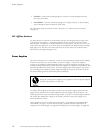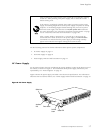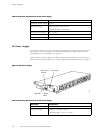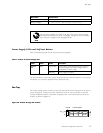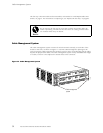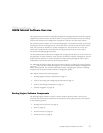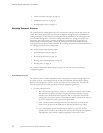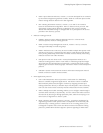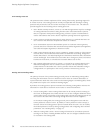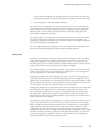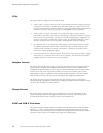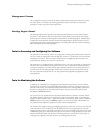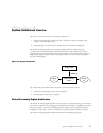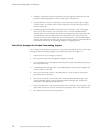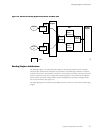Routing Engine So
ftware Components
IPv6 Routing Protocols
The JUNOS Inte
rnet software implements full IP routing functionality, p roviding support for
IP version 6 (IPv6). The routing protocols are fully interoperable with existing IP routing
protocols and provide the scale and control necessary for the Internet core. The software
provides supp
ort for the following unicast routing protocols:
• BGP—Border Gateway Protocol, version 4, is an EGP that guarantees loop-free exchange
of routing in
formation between routing domains (also called autonomous systems).
BGP, in conjunction with JUNOS routing p olicy, provides a system of adm inistrative
checks and balances that can be used to implement peering and transit agreements.
• ICMP—Internet Control Message Protocol router discovery is a method that hosts can
use to discover the addresses of operational routers on a subnet.
• IS-IS—Intermediate System-to-Intermediate System is a link-state interior gateway
protocol (IGP) for IP networks that uses the shortest-path-first algorithm (SPF algorithm,
also called
the Dijkstra algorithm) to determine routes.
• OSPF—Open Shortest Path First, version 3 (OSPFv3), supports version 6 of the Internet
Protocol (I
Pv6). The fundamental mechanisms of O SPF such as flooding, Designated
Router (DR) election, area based topologies and the Shortest Path First (SPF) calc ulations
remain unchanged. Some differences exist either due to changes in protocol semantics
between IPv
4 and IPv6, or to h andle the increased address size of IPv6.
• RIP—Routing Information Protocol, version 2, is an IGP for IP networks based on the
Bellman-F
ord algorithm. RIP is a distance-vector protocol. RIP dynamically routes
packets between a subscriber and a service provider without the subscriber having to
configureBGPortoparticipateintheserviceprovider’sIGPdiscoveryprocess.
Routing and Forwarding Tables
The primary function of the JUNOS routing protocol process is maintaining routing tables
and using the information in them to determine active routes to network destinations. It
copies information about the active routes into the Routing Engine’s forwarding table, which
the JUNOS kernel copies to the Packet Forwarding Engine.
By default, the routing protocol process maintains the following routing tables and uses the
information in each table to determine active routes to network destinations:
• Unicast routing table—Stores routing information for all unicast protocols running on
the router, including BGP, IS-IS, OSPF, and RIP. You can also configure additional routes,
such as static routes, for inclusion in the routing table. The unicast routing protocols use
the routes in this table when advertising routing information to their neigh bors.
In the unicast routing table, the routing protocol process designates routes with the
lowest preference values as active. By default, a route’s preference value is simply a
function of how the routing protocol process learned about the route. You can modify
the default preference value by setting routing policies and configuring other software
parameters. See “Routing Policy” on p age 25.
• Multicast routing table (cache)—Stores routing information for all multicast protocols
running on the router, including DVMRP and PIM. You can configure additional routes
for inclusion in the routing table.
24 M5 and M10 Internet Routers Hardware Guide



